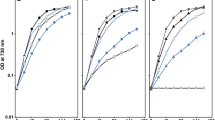Abstract
The simplest proton pump known in biological systems, bacteriorhodopsin (bR), is the first ion-transporting membrane protein, the function of which can be described at the atomic level, with the aid of molecular dynamics calculations. To get additional experimental support for the proposed atomic level description of the function of bR, we studied a quasi-stable state of the protein molecule, the so-called M intermediate that plays a crucial role in the proton pumping process. The temperature dependence of the light-induced events occurring in the photocycle of wild-type bacteriorhodopsin and its mutant D96N were followed in detail. Absorbance changes, electric signals generated by charge motion inside the protein, and movement of protons in the protein solution interface either forward (proton release due to excitation of bR) or backward (uptake of protons due to the M excitation: “back-take”) were monitored. The obtained Arrhenius parameters indicate that the proton back-take is triggered by charge rearrangements in the protein similar to the proton release triggered by those during the L → M transition. The time necessary for proton back-take determines the reconstitution time of the bR ground state. The data are expected to be used in theoretical modeling of the bR function. Based on these results, a more detailed photocycle model is established to describe the proton pumping mechanism, implying a formal principle ("domino model") that is expected to hold also for other charge transfer proteins.











Similar content being viewed by others
References
Stoeckenius W (1999) Protein Sci 8:447
Lanyi JK (2000) Biochim Biophys Acta 1460:1
Balashov SP (1995) Israel J Chem 35:415
Hessling B, Herbst J, Rammelsberg R, Gerwert K (1997) Biophys J 73:2071
Dér A, Keszthelyi L (2001) Biochemistry (Moscow) 66:1234
Karvaly B, Dancsházy Zs (1977) FEBS Lett 76:36
Ormos P, Dancsházy Zs, Keszthelyi L (1980) Biophys J 31:207
Dickopf S, Heyn MP (1997) Biophys J 73:3171
Ludmann K, Ganea C, Váró G (1999) J Photochem Photobiol B 49:23
Ormos P, Reinisch L, Keszthelyi L (1983) Biochim Biophys Acta 722:471
Trissl HW, Gärtner W, Leibl W (1989) Chem Phys Lett 158:515
Tóth-Boconádi R, Dér A, Taneva SG, Keszthelyi L (2006) Biophys J 90:2651
Tóth-Boconádi R, Taneva SG, Keszthelyi L (2001) J Biol Phys Chem 1:58
Luecke H, Schobert B, Richter HT, Cartailler JP, Lanyi JK (1999) Science 286:255
Hayashi S, Tajkhorshid E, Schulten K (2002) Biophys J 83:1281
Murata K, Fuji Y, Nobuyuki E, Hata M, Hoshino T, Tsuda M (2000) Biophys J 79:982
Bondar A-N, Suhai S, Fischer S, Smith JC, Elstner M (2007) J Struct Biol 157:454
Song Y, Mao J, Gunner MR (2003) Biochemistry 42:9875
Rousseau R, Kleinschidt W, Schmitt UW, Marx D (2004) Angew Chem Int Ed 43:4804
Garczarek F, Gerwert K (2006) Nature 439:109
Phatak P, Ghosh N, Yu H, Cui Q, Elstner M (2009) Proc Natl Acad Sci USA 105:19672
Dér A, Oroszi L, Kulcsár Á, Zimányi L, Tóth-Boconádi R, Keszthelyi L, Stoeckenius W, Ormos P (1999) Proc Natl Acad Sci USA 96:2776
Royant A, Edman K, Ursby T, Pebay-Peyroula E, Landau EM, Neutze R (2000) Nature 406:645
Lanyi JK, Schobert B (2003) J Mol Biol 328:439
Kouyama T, Nishikawa T, Tokuhisa T, Okamura H (2004) J Mol Biol 335:469
Edman K, Royant A, Larsson G, Jacobson F, Taylor T, Van Der EM, Landau EM, Pebay-Peyroula E, Neutze R (2004) J Biol Chem 279:2147
Sass HJ, Büldt G, Gessenich R, Hehn D, Neff D, Schlesinger R, Berendzen J, Ormos P (2000) Nature 406:649
Tóth-Boconádi R, Dér A, Fábián L, Taneva SG, Keszthelyi L (2009) Photochem Photobiol 85:609
Tóth-Boconádi R, Taneva SG, Fábián L, Dér A, Keszthelyi L (2007) J Biol Phys Chem 7:147
Dér A, Hargittai P, Simon J (1985) J Biochem Biophys Methods 10:295
Zimányi L, Saltiel J, Brown LS, Lanyi JK (2006) J Phys Chem A 110:2318
Tóth-Boconádi R, Dér A, Keszthelyi L (2000) Biophys J 78:3170
Tóth-Boconádi R, Dér A, Taneva SG, Tuparev N, Keszthelyi L (2001) Eur Biophys J 30:140
Porschke D (2002) J. Phys. Chem. B. 106:10233
Zimányi L, Kulcsár A, Lanyi JK, Sears DP, Saltiel J (1999) Proc Natl Acad Sci USA 96:4414
Tóth-Boconádi R, Taneva SG, Keszthelyi L (2001) J Photochem Photobiol B 65:122
Tóth-Boconádi R, Taneva SG, Keszthelyi L (2005) Biophys J 89:2605
Zimányi L, Váró G, Chang M, Ni BF, Needleman R, Lanyi JK (1992) Biochemistry 31:8535
Sasaki J, Shichida Y, Lanyi JK, Maeda A (1992) J Biol Chem 267:20782
Haupts U, Tittor J, Bamberg E, Oesterhelt D (1997) Biochemistry 36:2
Lanyi JK (1998) Biochim Biophys Acta 1365:17
Dogonadze RR, Kuznetzov AM, Ulstrup J (1977) J Theor Biol 69:239
Acknowledgments
Discussions with Prof. Sándor Suhai on the general aspects of the bacteriorhodopsin proton pump mechanism are gratefully acknowledged. The research was supported by the Hungarian National Science Fund (OTKA T-049489 and CK 78367). S.G.T. is a visiting professor at the University of the Basque Country and an associate member of the Institute of Biophysics Bulgarian Academy of Sciences.
Author information
Authors and Affiliations
Corresponding author
Additional information
Dedicated to Professor Sandor Suhai on the occasion of his 65th birthday and published as part of the Suhai Festschrift Issue.
Rights and permissions
About this article
Cite this article
Tóth-Boconádi, R., Dér, A., Taneva, S.G. et al. Excitation of the M intermediates of wild-type bacteriorhodopsin and mutant D96N: temperature dependence of absorbance, electric responses and proton movements. Theor Chem Acc 125, 365–373 (2010). https://doi.org/10.1007/s00214-009-0632-y
Received:
Accepted:
Published:
Issue Date:
DOI: https://doi.org/10.1007/s00214-009-0632-y




